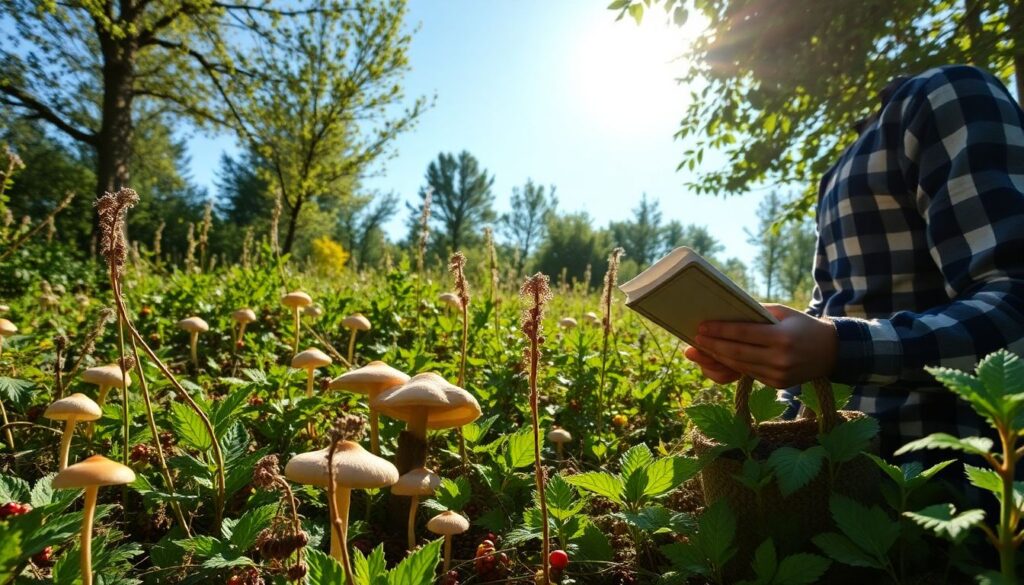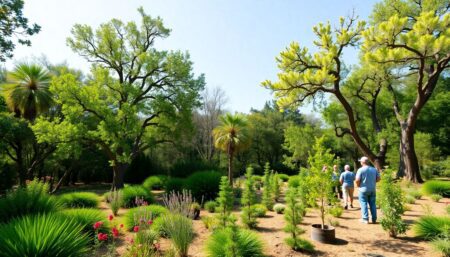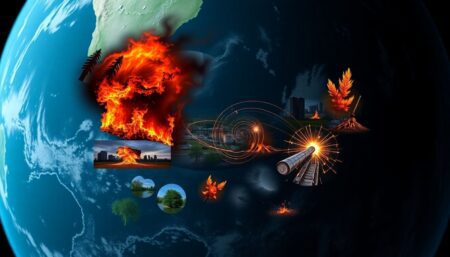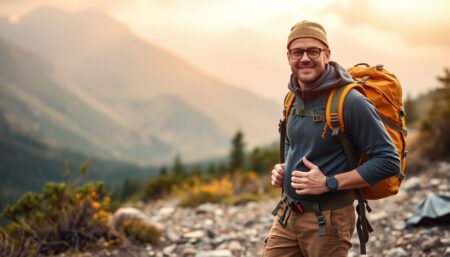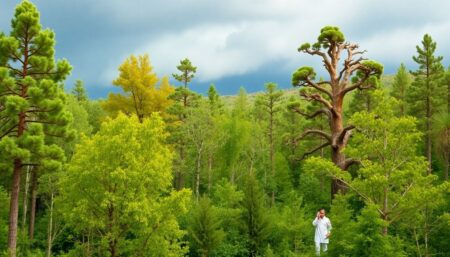undefined
Unveiling the Art of Wild Edibles for Survival and Self-Sufficiency
In the heart of nature’s vast pantry lies a treasure trove of wild edibles, waiting to be discovered by those who dare to venture off the beaten path. Unveiling the art of foraging is not just an adventure in gastronomy, but a journey towards self-sufficiency and survival. Imagine transforming the humble dandelion, often dismissed as a pesky weed, into a tangy salad green or a soothing tea. Picture the humble stinging nettle, once its sting is neutralized, becoming a nutritious pesto or a comforting soup. This is the magic of wild edibles, turning the ordinary into the extraordinary, the unwanted into the essential. But this art is not without its challenges. It demands patience, knowledge, and respect for the ecosystem. One must learn to discern between the edible and the toxic, the ripe and the unripe. It’s a dance with nature, a test of one’s wit and wisdom. Yet, the rewards are immense. Not only does it provide a sustainable source of food, but it also fosters a deep connection with the natural world. It’s a path to self-reliance, a journey into the wild, and an exploration of the untapped potential of our surroundings. So, let’s embark on this adventure, armed with curiosity, caution, and a sense of wonder. Let’s unveil the art of wild edibles, one green delight at a time.
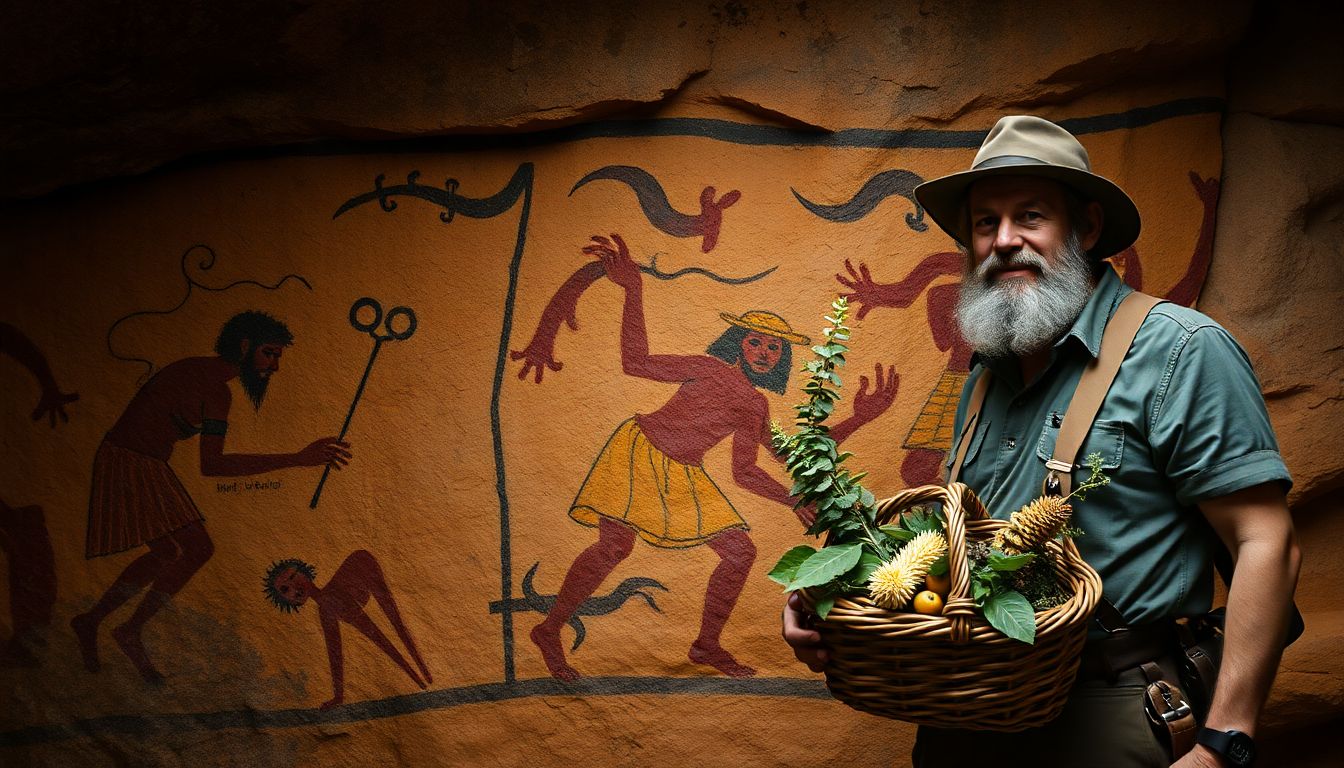
Understanding Foraging: A Brief History and Philosophy
Foraging, the practice of gathering wild food, is not merely a survival skill but a journey through time and a testament to our connection with nature. Its roots can be traced back to the dawn of humanity, when our ancestors relied solely on the bounty of the wild for sustenance. This ancient practice has evolved over millennia, shaping cultures and cuisines around the world. From the hunter-gatherer societies of the past to the modern-day foragers, the philosophy behind this art remains unchanged: respect, knowledge, and self-reliance.
The philosophy of foraging is deeply rooted in understanding the ecosystem. It’s about recognizing the interconnectedness of all living things and our role in this web of life. It’s about patience, observation, and humility. It’s about understanding that we are not separate from nature but a part of it. This understanding fosters a profound respect for the natural world, a respect that is reflected in the forager’s code of ethics: take only what you need, leave no trace, and give back to the ecosystem.
Foraging also embodies the spirit of self-reliance. It’s about trusting in one’s own abilities to provide for oneself, to read the signs of the natural world, and to transform the wild into nourishment. It’s about the satisfaction of providing for oneself, of being a part of the cycle of life rather than a consumer of it. This self-reliance is not about isolation but about interdependence, about understanding that our well-being is tied to the health of the ecosystem.
In essence, understanding the philosophy behind foraging enhances our appreciation for nature and our place in it. It’s about seeing the world not as a resource to be exploited but as a community to be nurtured. It’s about understanding that our survival is not separate from the survival of the natural world. It’s about respect, knowledge, and self-reliance. It’s about understanding that we are not just visitors in this world, but a part of it, and our actions have consequences. It’s about foraging not just for food, but for a deeper understanding of ourselves and our place in the world.
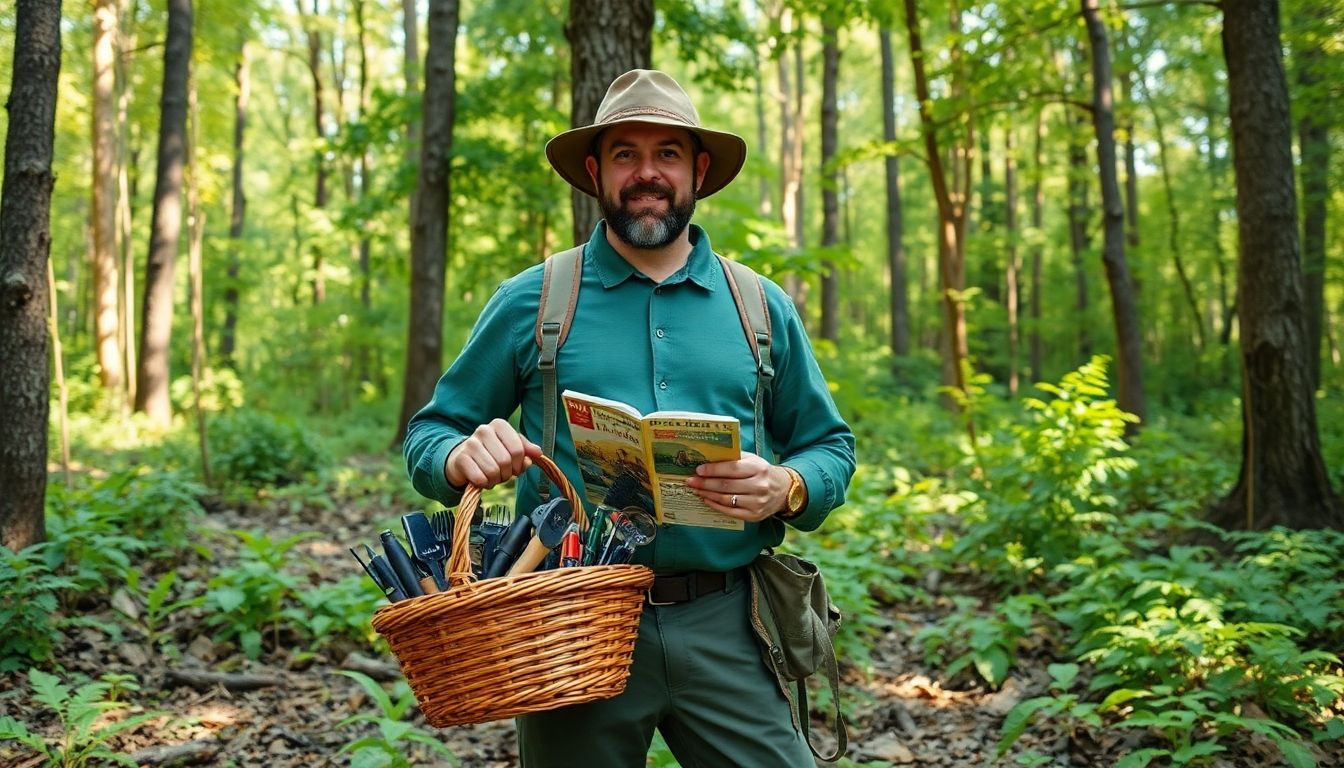
Essential Gear for the Modern Forager
Embarking on a foraging adventure in the modern world requires a blend of ancient wisdom and contemporary tools. The modern forager’s kit is a harmonious symphony of essential gear that ensures safety, efficiency, and enjoyment. Let’s delve into the necessary tools and equipment that will transform you into a capable and confident forager.
Field Guides and Identification Tools: The most crucial tool in a forager’s kit is a reliable field guide. These books, or increasingly, apps, are your key to the plant and fungi kingdom. They provide detailed illustrations, descriptions, and range maps, helping you distinguish edible species from their toxic look-alikes. A magnifying glass and a hand lens are also invaluable for scrutinizing tiny details that can make or break an identification.
Harvesting Tools: A sharp, durable knife is indispensable for harvesting. It should have a fixed blade for safety and a comfortable handle. Use it to cut stems, dig up roots, and carefully remove mushrooms from their substrate. Remember, a good knife is an investment in your safety and efficiency.
Containers: A sturdy basket or a canvas bag with a drawstring is ideal for collecting your foraged treasures. Unlike plastic bags, they allow air circulation, preventing your finds from becoming too damp and spoiling. For mushrooms, consider using a brush to clean them before placing them in your basket to avoid spreading spores.
Clothing and Accessories: Dress in layers, as temperatures can fluctuate, especially in the early morning or late evening. Long sleeves and pants protect you from thorns, bugs, and sunburn. Sturdy boots with good ankle support are a must for traversing uneven terrain. Don’t forget a hat for sun protection and gloves for handling prickly plants.
Safety and Navigation: Always carry a first aid kit, a map, and a compass (or a GPS device). Familiarize yourself with the area you’ll be foraging in, and let someone know where you’re going and when you expect to return. A whistle can be useful for signaling for help if needed.
Additional Tools: A trowel can help you dig up roots without damaging them. A pair of pruning shears can make light work of cutting back branches to reach hidden treasures. A small, lightweight tarp can provide a clean surface to sort and clean your finds.
Each of these tools plays a vital role in a successful foraging experience. They not only help you gather nature’s bounty but also ensure your safety and enjoyment. So, gear up, get out there, and happy foraging!
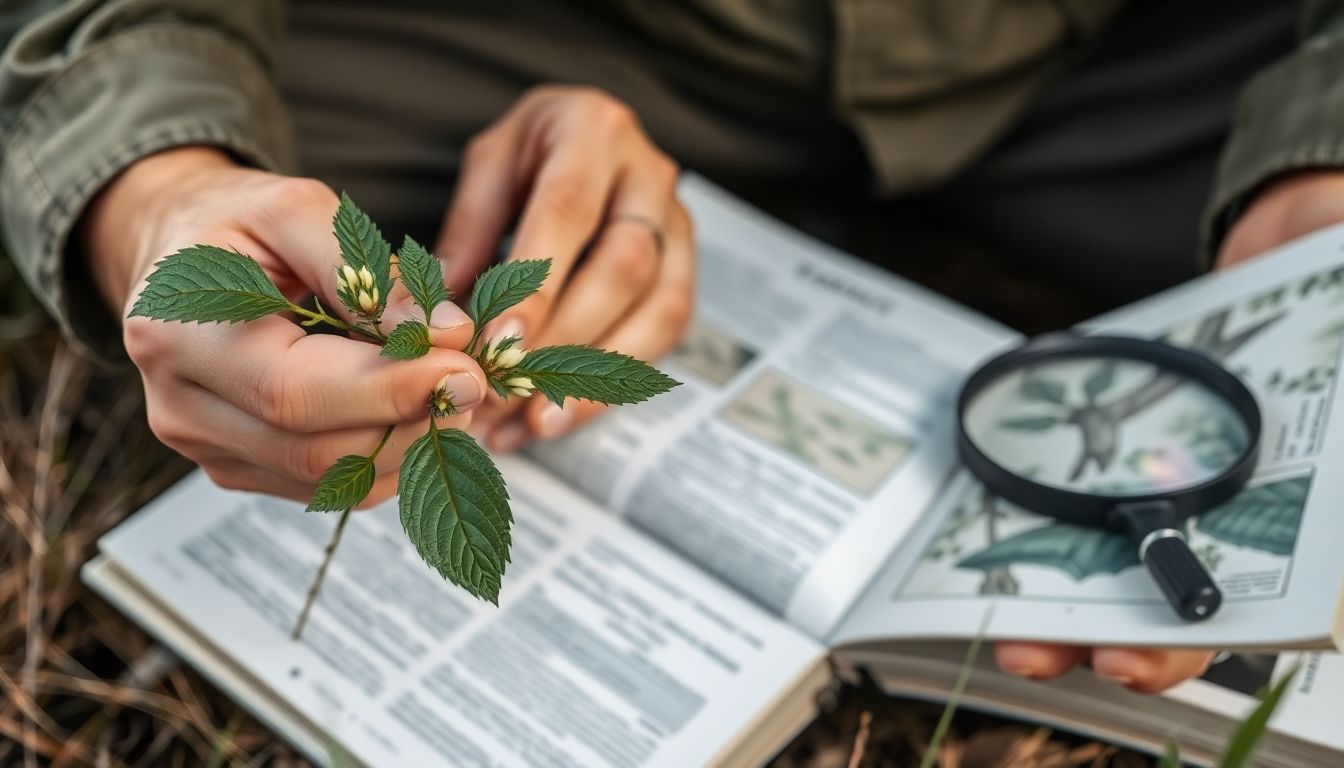
The Art of Plant Identification: Key Features and Safety Tips
Embarking on the journey of plant identification is like stepping into a green, leafy world of discovery. It’s an art that combines keen observation, a bit of botanical knowledge, and a healthy dose of patience. The first step in this art is understanding the key features that make each plant unique.
Start by examining the plant’s overall growth habit. Is it a tall tree, a sprawling shrub, or a low-growing herb? This can often narrow down your search significantly. Next, turn your attention to the leaves. Their shape, size, arrangement on the stem, and whether they are simple or compound can provide valuable clues. The texture and color of the leaves can also be telling.
Flowers, when present, are another rich source of information. Their color, shape, size, and arrangement on the plant can all be key identifiers. The number of petals, sepals, and other parts of the flower can also be useful. Don’t forget to look at the plant’s fruit and seeds, if present. Their size, shape, and color can provide additional insights.
Patterns can also be your friend in plant identification. The arrangement of leaves on a stem, the way flowers are grouped, or the overall growth pattern of the plant can all provide helpful clues.
However, it’s crucial to remember that accurate identification is not just about ticking off a list of features. It’s also about safety. Some plants are poisonous, others may cause skin irritation, and some can even be mistaken for dangerous look-alikes. Always use a reliable field guide or consult with an expert before consuming or handling any plant.
Field guides are your best friend in plant identification. They provide detailed illustrations and descriptions of plants, often including range maps to help you determine if a plant is likely to be found in a particular area. They also often include safety information, warning you of any poisonous or irritating plants. Always carry a field guide with you, and don’t be afraid to use it. The more you practice, the more familiar you’ll become with the plants in your area, and the more confident you’ll become in your identifications.
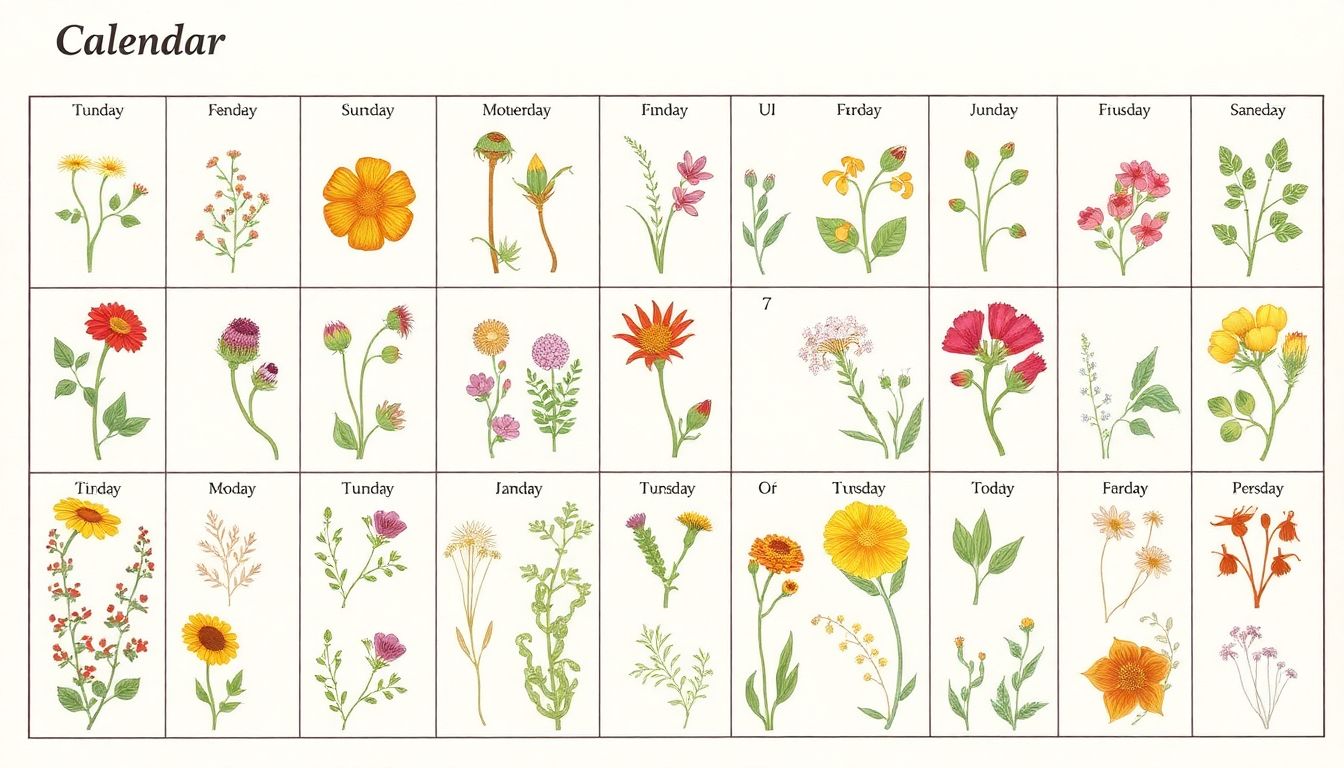
Seasonal Foraging: What to Expect Throughout the Year
Embarking on a year-long foraging adventure is like unraveling a vibrant tapestry, each season unveiling a new palette of wild edibles. Let’s explore the seasonal variations in our natural pantry, guiding you through the best times to forage for an array of plants, mushrooms, and berries.
The year begins with the crisp, invigorating breath of winter. While the landscape may seem barren, a closer look reveals hardy greens like dandelion (Taraxacum officinale) and purslane (Portulaca oleracea) pushing through the snow. Keep an eye out for wintercress (Barbarea verna), a peppery green that thrives in cold weather. Mushroom hunters, this is your time for morels (Morchella spp.) and pheasant back (Polyporus squamosus).
Spring arrives with a burst of color and an abundance of greens. Ramps (Allium tricoccum) and fiddleheads (Matteuccia struthiopteris) are early spring delights, followed by a profusion of wild greens like stinging nettle (Urtica dioica), lamb’s quarters (Chenopodium album), and garlic mustard (Alliaria officinalis). Berries start to make an appearance with serviceberries (Amelanchier spp.) and juneberries (Amelanchier spp.).
Summer is a berry bonanza! Strawberries (Fragaria spp.), raspberries (Rubus idaeus), blackberries (Rubus fruticosus), and blueberries (Vaccinium spp.) ripen, painting the landscape with hues of red, purple, and blue. Mushroom lovers, this is your season for porcini (Boletus edulis) and chanterelles (Cantharellus spp.).
Autumn is a symphony of color and flavor. Apples (Malus spp.) and pears (Pyrus spp.) fall from the trees, while nuts like acorns (Quercus spp.) and hickory nuts (Carya spp.) litter the forest floor. Mushrooms like hen-of-the-woods (Maitake, Grifola frondosa) and chicken-of-the-woods (Laetiporus spp.) make their appearance. Berries like elderberries (Sambucus spp.) and rose hips (Rosa spp.) are ready for picking.
Each season offers a unique bounty, so grab your basket and explore the ever-changing feast that nature provides.
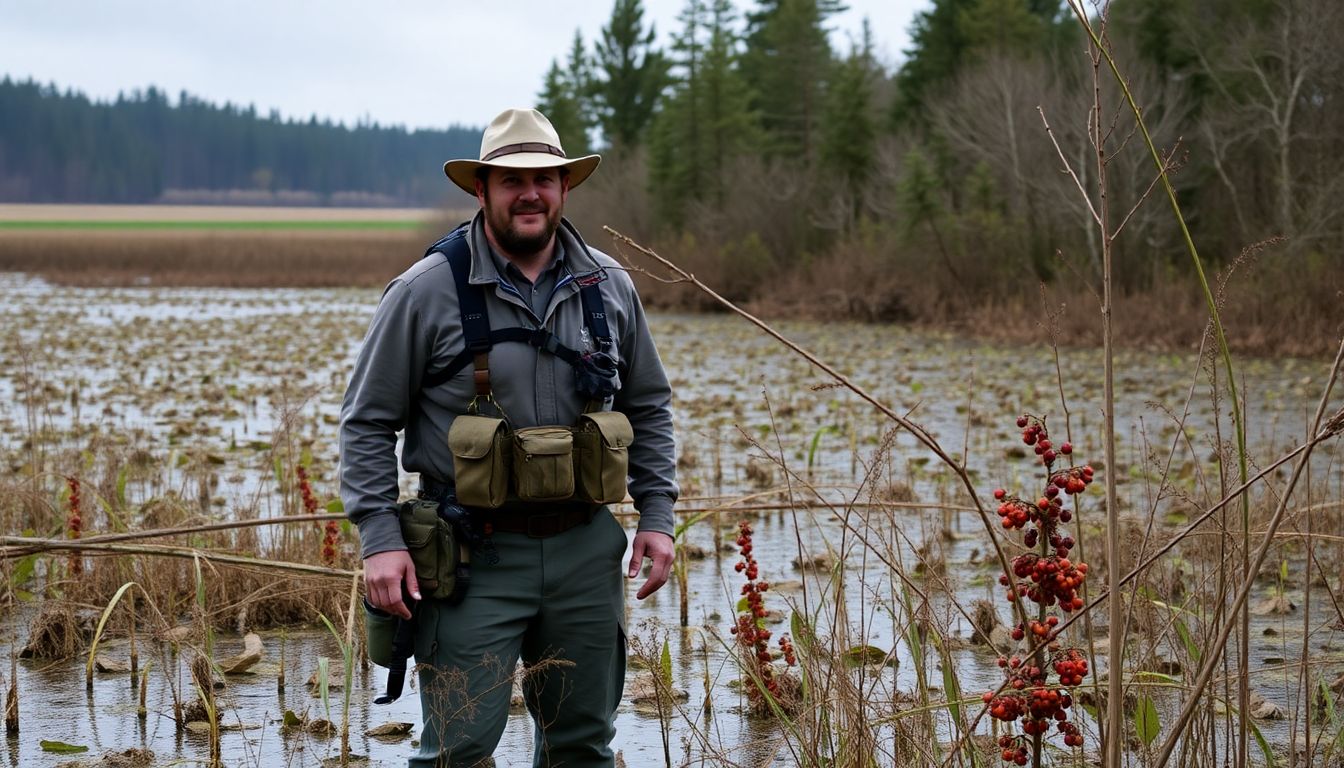
Foraging in Different Environments: Woods, Fields, and Wetlands
Foraging, the ancient practice of gathering wild food, offers a unique connection to nature and a chance to sample the diverse flavors of the wild. Each environment, from the dense woods to the expansive fields and the mysterious wetlands, presents a unique tapestry of edible delights, each with its own set of challenges and rewards.
The woods, with their dappled sunlight and cool, damp floors, are a treasure trove of wild edibles. Here, you’ll find the delicate morel mushrooms pushing through the leaf litter in early spring, their honeycomb caps a stark contrast to the earthy tones of the forest floor. The woods are also home to the tangy wild leeks, their broad, green leaves and white bulbs a sure sign of spring. However, foraging in the woods can be challenging, with paths often obscured by underbrush and the risk of getting lost always present. But with a good map, a reliable compass, and a keen eye for patterns, the woods yield their secrets generously.
Fields, on the other hand, offer a more open, expansive foraging experience. Here, you’ll find the sweet, juicy berries of the blackberry and raspberry bushes, their thorny canes a testament to their resilience. The fields are also home to the humble dandelion, its leaves and flowers both edible and packed with nutrients. Foraging in fields can be less challenging than in the woods, with clear paths and plenty of sunlight. However, it’s important to be aware of any pesticides or herbicides that may have been used on the land.
Wetlands, with their muddy banks and murky waters, may seem like an unlikely place to find food. But look closely, and you’ll find the crisp, refreshing watercress growing in the cool, clear streams that feed the wetlands. The wetlands are also home to the starchy, nutritious cattail, whose young shoots can be eaten like asparagus. Foraging in wetlands can be rewarding, but it’s important to be aware of the delicate ecosystem and to take care not to disturb the plants or the wildlife.
Each environment offers a unique foraging experience, with its own set of challenges and rewards. Whether you’re in the woods, the fields, or the wetlands, the key to successful foraging is to approach each environment with respect, knowledge, and a sense of adventure.

Mushroom Hunting: The Fungal Frontier
Embarking on a mushroom hunt is like stepping into a hidden, earthy world, where the familiar forest floor transforms into a mysterious fungal frontier. Mushrooms, the fruiting bodies of fungi, come in a dazzling array of shapes, sizes, and colors, each with its unique story to tell. They can be found in a variety of habitats, from the damp, shady undergrowth of deciduous forests to the coniferous woods, and even in urban parks, given the right conditions.
Identifying mushrooms can be both a rewarding and daunting task. It’s like learning a new language, where each species has its own set of characteristics
- the shape and size of the cap, the color and texture of the gills, the presence or absence of a ring around the stem, and even the habitat in which it’s found. The key to successful identification is patience and thorough observation. Start with the basics
- is the cap convex or flat? Are the gills attached to the stem or free? This will help narrow down the possibilities.
However, it’s crucial to remember that not all mushrooms are created equal. Some are culinary delights, like the meaty portobello or the delicate morel, while others are best left untouched, such as the death cap, one of the most poisonous mushrooms in the world. This is where proper identification becomes not just a hobby, but a matter of safety. It’s not enough to know what a mushroom looks like; you must also know what it doesn’t look like. A good rule of thumb is to avoid any mushroom with white gills, as many poisonous species have this characteristic.
For those interested in the culinary uses of mushrooms, the possibilities are vast. They can be sautéed, grilled, pickled, or even dried for later use. Some, like the morel, have a unique, honeycomb-like texture that makes them a prized ingredient in many dishes. However, it’s important to note that not all edible mushrooms are delicious, and not all delicious mushrooms are edible. It’s always best to consult with an expert or a reliable guide before incorporating a new species into your cooking.
In conclusion, mushroom hunting is an adventure that combines the thrill of discovery with the responsibility of accurate identification. It’s a chance to connect with nature in a unique way, to learn a new language, and to expand your culinary horizons. So, grab your basket, your field guide, and your sense of adventure, and step into the fascinating world of mushrooms. Just remember, when it comes to these fungi, it’s always better to be safe than sorry.

Preserving and Storing Your Foraged Harvest
Foraging is a rewarding way to connect with nature and gather delicious, nutritious foods. However, the seasonality of foraged ingredients can pose a challenge when it comes to enjoying them year-round. The solution? Preservation! Let’s explore various methods to store and preserve your foraged harvest, each with its unique benefits and techniques.
Drying:
This ancient method is simple, energy-efficient, and perfect for preserving delicate leaves, herbs, and mushrooms. Drying removes moisture, preventing bacterial growth and halting the spoilage process. To dry foraged foods, start by cleaning and preparing them as needed. For leaves and herbs, remove stems and rinse gently. For mushrooms, slice or quarter them to ensure even drying. Arrange your foraged treasures on a dehydrator tray or a baking sheet lined with parchment paper. Set your dehydrator to 95°F (35°C) or your oven to its lowest setting with the door slightly ajar. Drying times vary, but it typically takes 4-12 hours. Once dried, store your preserved goods in airtight containers in a cool, dark place.
Freezing:
Freezing is ideal for preserving fruits, berries, and some vegetables. This method retains color, flavor, and nutrients, making it a popular choice for foragers. To freeze your harvest, start by cleaning and preparing your foraged foods. For berries, spread them out on a baking sheet lined with parchment paper and freeze until solid. Once frozen, transfer them to an airtight container or freezer bag. For other foods, blanch them briefly in boiling water to preserve color and texture, then freeze as described above. Frozen foraged foods can last up to a year, making them a convenient way to enjoy the fruits of your labor year-round.
Canning:
Canning is a reliable method for preserving high-acid foods like fruits and some berries. This process involves heating foods in sealed jars to kill bacteria and create a vacuum seal, preventing spoilage. To can your foraged harvest, start by cleaning and preparing your foods. For fruits, you’ll typically need to add sugar or acid (like lemon juice) to create a safe pH level for canning. Follow a trusted recipe for your specific fruit, then process your jars in a boiling water bath according to USDA guidelines. Properly canned goods can last for years on your pantry shelf.
Fermenting:
Fermentation is a natural, probiotic-rich method for preserving vegetables, fruits, and even some herbs. This process involves submerging your foraged foods in a brine solution and allowing beneficial bacteria to convert sugars into lactic acid, creating a tangy, preserved food. To ferment your harvest, start by cleaning and preparing your foods. For vegetables, you’ll typically need to submerge them in a brine solution with a specific salt-to-water ratio. For fruits, you may need to add sugar to create a safe environment for fermentation. Allow your ferments to sit at room temperature for several days to a few weeks, depending on the desired level of tanginess. Once fermented, store your creations in the refrigerator for up to several months.
Each preservation method offers unique benefits and caters to different foraged foods. By mastering these techniques, you’ll be well on your way to enjoying the fruits (and leaves, and berries, and mushrooms) of your labor all year long!
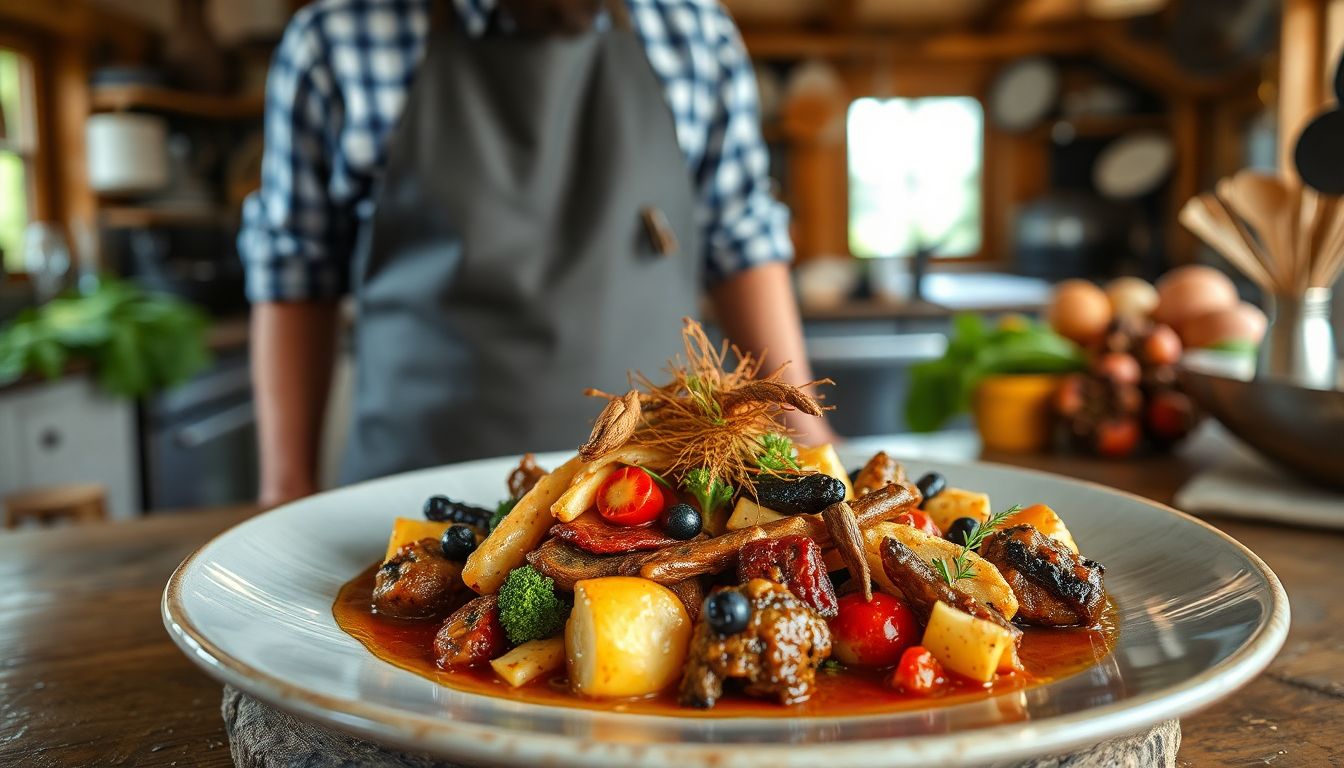
Cooking with Wild Ingredients: Recipes and Culinary Adventures
Embark on a culinary journey like no other with ‘Cooking with Wild Ingredients’! This gastronomic adventure celebrates the untamed, the wild, and the often overlooked ingredients that nature has to offer. From the tangy burst of a wild blackberry to the earthy aroma of a freshly foraged mushroom, wild ingredients bring a unique, untamed flavor to our plates.
Let’s start with a refreshing wild salad. Imagine a bed of peppery wild arugula, topped with crisp shavings of Parmesan, and a drizzle of honey-sweetened balsamic glaze. The bitterness of the arugula is balanced by the sweetness of the honey, creating a symphony of flavors that dance on your tongue. But the nutritional benefits are no less impressive. Arugula is packed with vitamins K, A, and C, while the honey offers antibacterial and anti-inflammatory properties.
Now, let’s move on to a hearty wild soup. How about a creamy wild leek and potato soup? The leeks, with their delicate onion flavor, are sautéed until soft, then blended with earthy potatoes and a splash of cream. The result is a comforting, velvety soup that’s as nourishing as it is delicious. Wild leeks are not only delicious but also packed with antioxidants and have been known to boost the immune system.
For a main dish, consider a wild game stew. Venison, with its lean, robust flavor, is slow-cooked with an assortment of wild mushrooms, carrots, and onions. The meat becomes tender and succulent, while the mushrooms add a deep, umami-rich flavor. This dish is not only a taste sensation but also a nutritional powerhouse, providing high-quality protein and essential minerals like iron and zinc.
And what’s a culinary adventure without a sweet finish? Try a wild berry crumble. A medley of wild berries, from tart red currants to sweet blackberries, is topped with a crumble of oats, nuts, and a touch of honey. Baked until golden, this dessert is a celebration of nature’s sweetness. Plus, the berries are packed with antioxidants and fiber, making this a dessert you can feel good about.
So, are you ready to step into the wild and explore the untamed flavors of nature? With ‘Cooking with Wild Ingredients’, every meal is an adventure, every bite a discovery. Bon appétit!

Foraging Ethics and Sustainability: Leave No Trace
Foraging, the practice of gathering wild plants, fungi, and even insects for food or other uses, is an ancient and increasingly popular activity. However, with its resurgence in popularity, it’s crucial to consider the ethical and sustainable aspects of this pastime. The principle of ‘leave no trace’ is not just a guideline for campers; it’s a fundamental ethic that foragers must embrace to ensure the preservation of natural habitats.
The first step in ethical foraging is to educate oneself about the plants and their ecosystems. This knowledge helps in understanding which plants are safe to consume, their seasonality, and their role in the ecosystem. It’s also important to learn about the local regulations regarding foraging, as some areas may have restrictions or require permits.
One of the key principles of ‘leave no trace’ is to take only what you need. This means foraging in moderation and never overharvesting. It’s also crucial to consider the plant’s life cycle. For instance, it’s best to avoid harvesting the first flowers of a plant, as they are often necessary for pollination and reproduction.
Another important aspect is to respect the plant’s habitat. This includes not disturbing the soil, not trampling plants, and not foraging in sensitive areas like wetlands or near water sources. It’s also important to avoid foraging in areas that are already stressed or have been disturbed by human activity.
Moreover, it’s our responsibility as foragers to help preserve the environment. This can be done by removing invasive species, planting native species, and even helping in conservation efforts. It’s also important to share our knowledge with others, promoting ethical and sustainable foraging practices.
In conclusion, ethical and sustainable foraging is not just about what we take from the wild, but also about what we give back. By following the principles of ‘leave no trace’ and respecting the plants and their habitats, we can ensure that future generations can continue to enjoy the benefits of foraging.

Foraging Communities and Resources: Connecting with Others
Embarking on the journey of foraging, one quickly realizes the wealth of knowledge and camaraderie that lies within local communities and online resources. These connections, when nurtured, can significantly enhance one’s foraging skills and deepen understanding of the natural world.
The benefits of engaging with local foraging communities are manifold. Firstly, these communities are a treasure trove of local knowledge. Members, often seasoned foragers, share insights into the best times and places to find specific plants, as well as their uses and potential hazards. They can guide you through the intricacies of identifying edible species, ensuring safety and sustainability in your foraging practices.
Moreover, local communities foster a sense of belonging and shared purpose. They organize group forays, workshops, and potlucks, providing opportunities to learn, share, and celebrate the joy of foraging together. These gatherings can also promote environmental stewardship, as members often collaborate on projects like trail maintenance or invasive species removal.
Online resources, too, play a pivotal role in the modern forager’s toolkit. Forums and social media groups offer year-round access to a global network of foragers. Here, you can find real-time information on plant identification, ask questions, and learn from others’ experiences. Some platforms even host virtual workshops and webinars, allowing you to learn from experts from the comfort of your home.
To maximize these benefits, consider the following steps:
- Join local foraging groups and attend their meetings and events.
- Participate in online forums and social media groups, contributing to discussions and asking questions.
- Sign up for newsletters and online courses offered by reputable foraging organizations.
- Attend workshops and webinars to learn from experienced foragers and educators.
By actively engaging with these communities and resources, you’ll not only expand your foraging knowledge and skills but also cultivate a deeper connection with the natural world and like-minded individuals.



